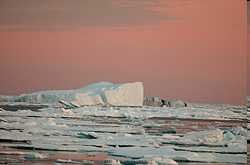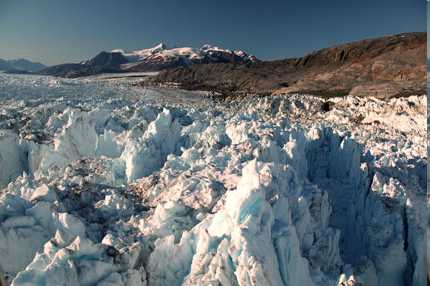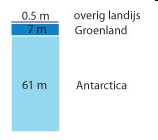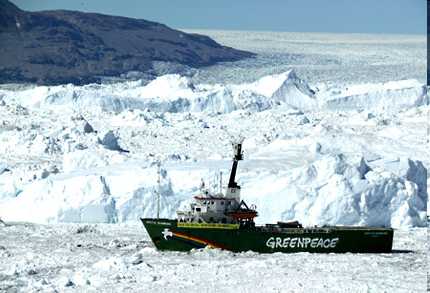|
Kangerdlugssuaq melting
You ever commute to work, and find your
office building missing when you get there? That's probably what it felt
like this Monday morning for University of Maine glaciologist Dr. Gordon
Hamilton.
 He
was commuting to his place of work (a glacier of course) with Hughie,
flying the helicopter, and Melanie, one of our campaigners in the back
seat. Gordon, along with his PhD student Leigh Stearns, had already
plotted exactly where they wanted to place their precision GPS
receivers, a kilometer from the front of the glacier. But arriving at
the research coordinates, Gordon discovered something was missing.
"Yeah, it was quite a surprise when we came up here this morning," he
explained later, "and found that as we flew over the way points marked
for the survey grid, we were still over water and the calving front of
the glacier was quite a bit further up the fjord." He
was commuting to his place of work (a glacier of course) with Hughie,
flying the helicopter, and Melanie, one of our campaigners in the back
seat. Gordon, along with his PhD student Leigh Stearns, had already
plotted exactly where they wanted to place their precision GPS
receivers, a kilometer from the front of the glacier. But arriving at
the research coordinates, Gordon discovered something was missing.
"Yeah, it was quite a surprise when we came up here this morning," he
explained later, "and found that as we flew over the way points marked
for the survey grid, we were still over water and the calving front of
the glacier was quite a bit further up the fjord."
The Kangerdlugssuaq glacier has been surveyed using aerial and satellite
images since 1962. In all that time (and very likely for quite some time
before) its front has remained remarkably stable.
Now, over just a few years, it's retreated roughly three miles (5km).
Previous research, done by NASA, had shown the glacier thinning at a
rapid rate - about 33 feet (10m) per year. It had been a little puzzling
to Gordon how the glacier could thin so fast without retreating. As he
says, "Of course, when we flew over Monday morning, once we saw the
quite large retreat, it started to make sense."
A fast flowing ice river
Plotting a new research grid, Gordon and Leigh went about the work of
measuring how fast the ice that makes up this glacier is flowing
downhill.
 Work
that was complicated by 20 knot winds, and a more chaotic glacial
surface than any they'd ever been on before [check]. Towering pinnacles
ready to collapse, tiny landing zones, and crevasses hidden under the
weathered surface by ice debris all hampered their efforts. Nonetheless,
the science team spent far longer out on this glacier than any other on
this trip - taking additional measurements to try and figure out what's
going on here. Work
that was complicated by 20 knot winds, and a more chaotic glacial
surface than any they'd ever been on before [check]. Towering pinnacles
ready to collapse, tiny landing zones, and crevasses hidden under the
weathered surface by ice debris all hampered their efforts. Nonetheless,
the science team spent far longer out on this glacier than any other on
this trip - taking additional measurements to try and figure out what's
going on here.
Their extra work paid off, though, and brought them another surprise.
When this glacier was last measured, in 1995, it was flowing at a fairly
speedy (for a glacier) 3.72 miles (6km) per year. Yet, preliminary
results from Gordon and Leigh's survey suggest that since then it's
speed has more than doubled, to almost nine miles (14km) per year -
making it one of the word's fastest. As Gordon put it, "that's pretty
staggering."
All this ice has to come from somewhere. In this case, as with many
other Greenland glaciers, it's flowing from the Greenland ice sheet. Not
that the ice sheet itself will disappear completely anytime soon. That
would take hundreds and hundreds of years.
But if the Kangerdlugssuaq glacier is an example of what's to come, then
it could go much faster than current models predict. In fact, we could
be looking at several feet of sea level rise over the next hundred years
- enough to wreck massive damage. More than 70 percent of the world's
population lives on coastal plains, and 11 of the world's 15 largest
cities are on the coast or estuaries. Weather patterns would also change
as the ice sheet shrinks. And the millions of gallons of melted ice
water would alter regional seawater salinity and global ocean currents.
In short, if the Greenland ice sheet is in fact draining rapidly it will
be a disaster of global proportions.
We'll keep doing our part by bringing you news from the frontlines of
climate change, but we need you to join us in action. Everyone needs to
pitch in, but if you're in the U.S. (the world's biggest global warming
polluter per capita) your help is especially needed.
|

 Groenlandse gletsjer breekt alle records
Groenlandse gletsjer breekt alle records
 He
was commuting to his place of work (a glacier of course) with Hughie,
flying the helicopter, and Melanie, one of our campaigners in the back
seat. Gordon, along with his PhD student Leigh Stearns, had already
plotted exactly where they wanted to place their precision GPS
receivers, a kilometer from the front of the glacier. But arriving at
the research coordinates, Gordon discovered something was missing.
"Yeah, it was quite a surprise when we came up here this morning," he
explained later, "and found that as we flew over the way points marked
for the survey grid, we were still over water and the calving front of
the glacier was quite a bit further up the fjord."
He
was commuting to his place of work (a glacier of course) with Hughie,
flying the helicopter, and Melanie, one of our campaigners in the back
seat. Gordon, along with his PhD student Leigh Stearns, had already
plotted exactly where they wanted to place their precision GPS
receivers, a kilometer from the front of the glacier. But arriving at
the research coordinates, Gordon discovered something was missing.
"Yeah, it was quite a surprise when we came up here this morning," he
explained later, "and found that as we flew over the way points marked
for the survey grid, we were still over water and the calving front of
the glacier was quite a bit further up the fjord."  Work
that was complicated by 20 knot winds, and a more chaotic glacial
surface than any they'd ever been on before [check]. Towering pinnacles
ready to collapse, tiny landing zones, and crevasses hidden under the
weathered surface by ice debris all hampered their efforts. Nonetheless,
the science team spent far longer out on this glacier than any other on
this trip - taking additional measurements to try and figure out what's
going on here.
Work
that was complicated by 20 knot winds, and a more chaotic glacial
surface than any they'd ever been on before [check]. Towering pinnacles
ready to collapse, tiny landing zones, and crevasses hidden under the
weathered surface by ice debris all hampered their efforts. Nonetheless,
the science team spent far longer out on this glacier than any other on
this trip - taking additional measurements to try and figure out what's
going on here.